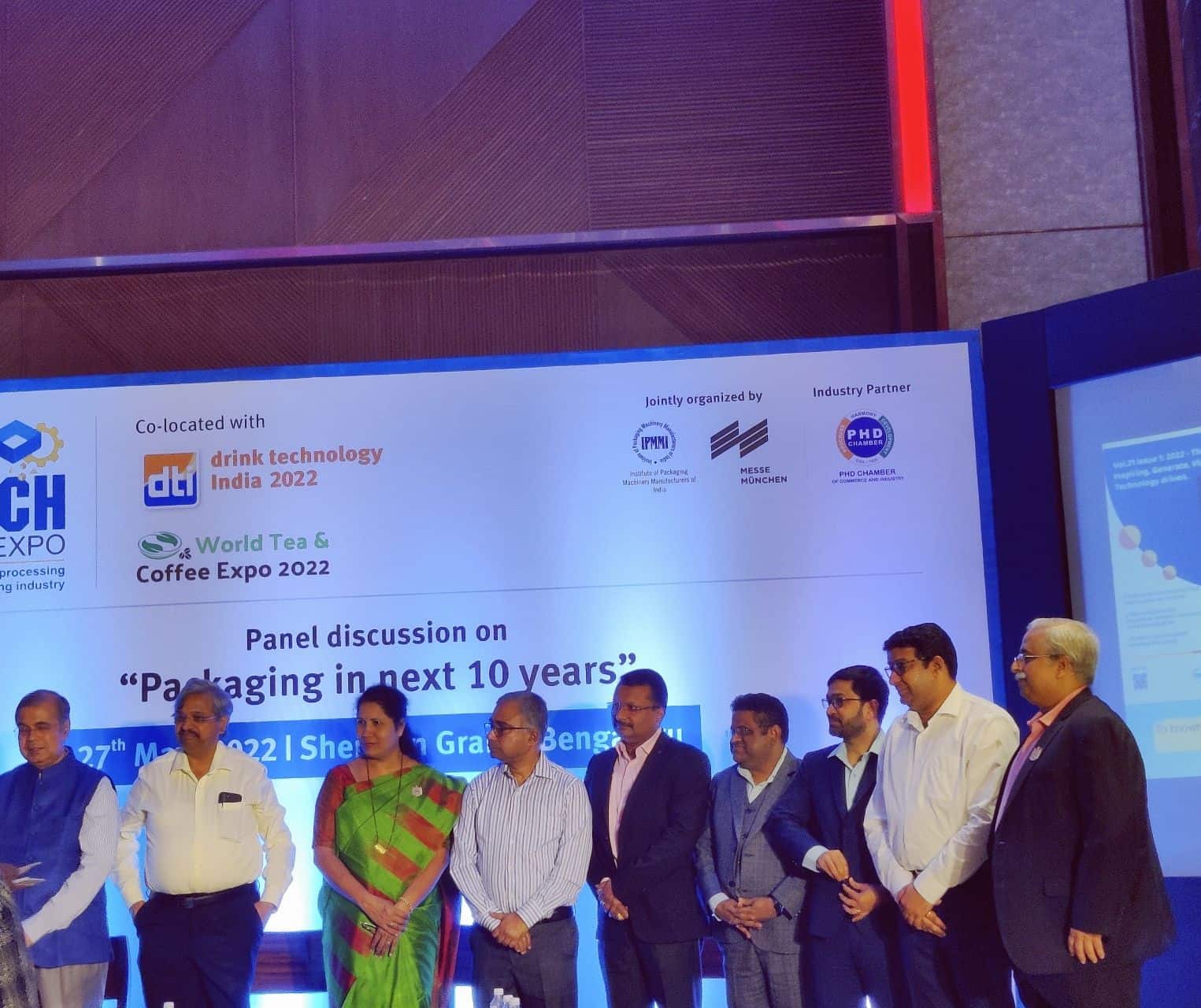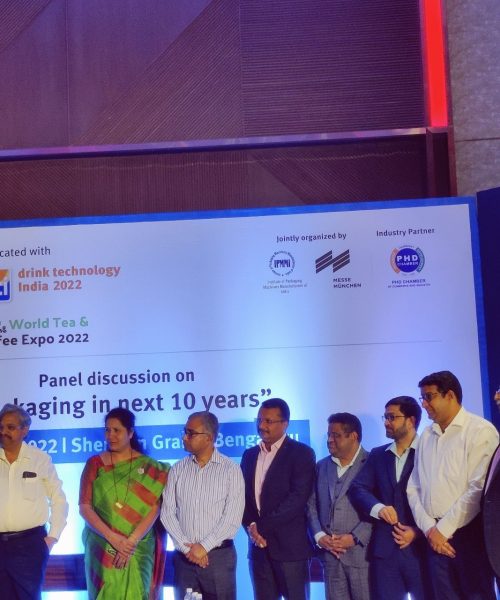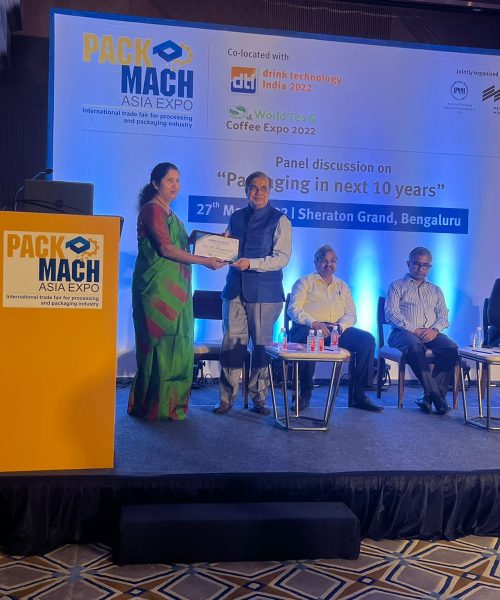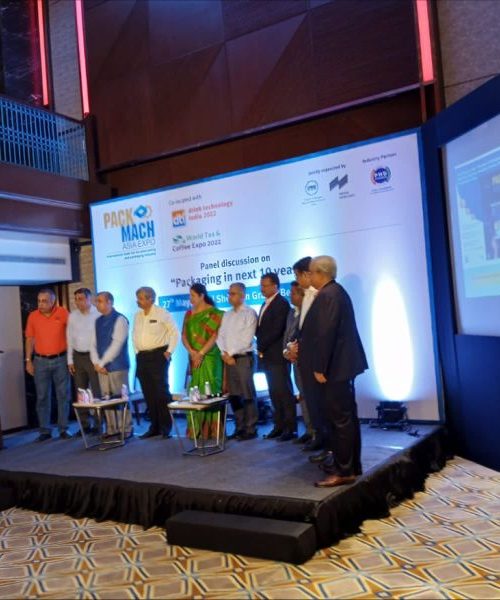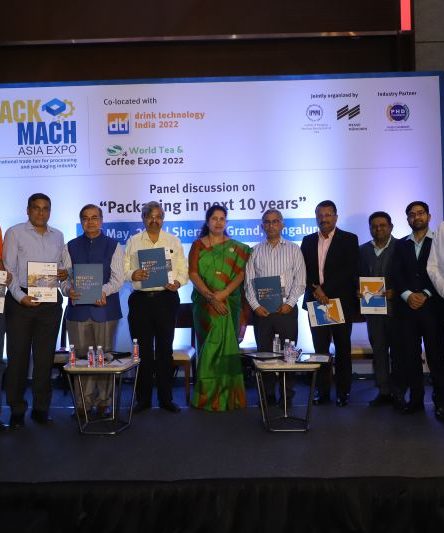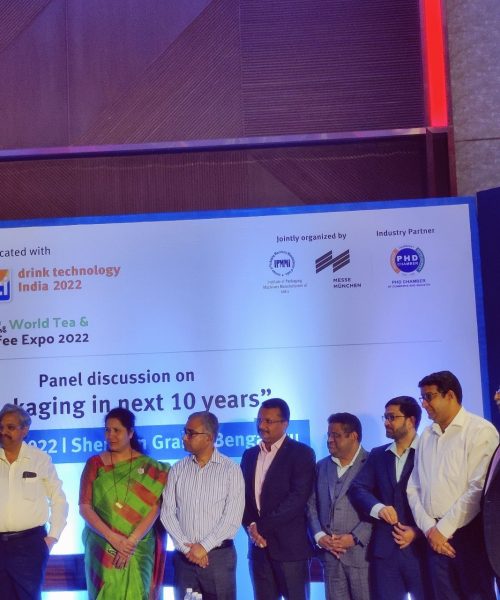Post Event Report On PANEL DISCUSSION FOR BANGLORE ROADSHOWHeld On 27thMay, 2002 at Sheraton Grand
The theme of the panel discussion was “Packaging in the Next ten Years” organized as part of the roadshow hosted by Messe Meunchen India, in collaboration with IPMMI , PHDC.
An illustrious panel comprising Packaging Heads from Leading brands & Machinery & Operations segment were invited to share their narrative on the theme. Dr.R. Rangaprasad, Business Head Packaging 360 moderated the session.For better coverage of all the topics, two panels were constituted.
Dr. Rangaprasad set the panel discussion by explaining the context of the theme & introduced the panellists.
Mr. Amit Saurkar, Head Packaging MTR Foods, Mr. Santosh Panda, Manager Britannia Industries Limited &Mr. Ravi Kiran Namushakavi, Director, Valco Melton were members of the first panel.
Mr. Amit Saurkar, began his narrative by stating thatPackaging has evolved over the years. In 1920 packaging was just protection, in 20th century packaging was presentation, brand building, transport and marketing and in 21st century packaging is aimed at being sustainable, recyclable, eco-friendly. In an online, digital and E market era, when your potential customers are doing research about buying your product, the FMOT (stands for First Moment of Truth) is the deciding factor. Now packaging has become ZMOT (Zero Moment of Truth) in the buying process when the consumer researches a product prior to purchase. Ready to eat food is a gift for food industry given by CFTRI, DFRL and MTR foods. Barrier multilayer flexible packaging material suitable for retort process is used for RTE products. Single polymer PP retortable structure is suitable for retort, such development is in progress. Current millennial generation do not have time or inclination to make food and they prefer ON THE GO food. Hence, MTR introduced 3 minutes meal
concept which shows that the times are changing and businesses will have to evolve with growing consumer demands.
Shelf ready packaging, E commerce friendly packaging, concept of variable QR codes, smart packaging, Packages with RFID patches such concepts are coming in near future when manufacturing, sales team and customer can track products journey. In next 5 years lots of things in harmonisation and rationalisation will be introduced in digital front. We have to gear up for metaverse where customer can get real time experience of supermarket sitting at home where packaging will play a key role for selection of your product. Very stringent norms will be imposed by the government for food safety point. The most important mantra is to learn-unlearn and relearn to come out from conventional way of packaging. You learn, then the world changes. We need to unlearn what is holding us back, and we need to relearn what will help us move forwards towards success.
Mr. Santosh Panda,Britannia– Britannia is mainly in breads, biscuits and snacks and currently more than 70% packaging is in flexible packaging materials. The current trend is to replace plastic withpaper-based packaging. Now plastic is treated as an evil. Barrier property of paper is the main concern as biscuits and snacks require best WVTR and MVTR properties in packaging material. Experts are working on various coatings for paper but direct contact of the barrier coating to food products needs testing and validation. Currently cost and availability of paper-based packaging material is also an issue but once demand will go up, cost will come down. Britannia is working on reducing secondary packaging material and moving from plastic thermoforming trays to paper-based trays. People are liking zero waste concept and plastic containers; rigid containers and paper-based canister packaging is preferred by the customers. Bread is price sensitive product and it is difficult to change to costly packaging material. For snacks packing, 3 to 4 layers of various barriers laminated to get seal integrity, oxygen barrier, nitrogen purging so directly shifting to paper based is difficult but paper plus polyethylene structure trials are in progress. Biscuit packing machines are high speed lines so machines are not suitable for paper-based material.
In conclusion, cost and availability, customers demand and trend for plastic less packaging and operative challenges are the challenges in next 10 years in packaging industry.
Mr. Ravikiran, Valco Melton– We are moving to Industry 4.0. Packaging also aims to becomecompletely data driven. RFID tags and cloud-based packaging data tracking is the coming future in this industry. Zero manual intervention inspection systems, faulty packaging rejection in end of line, E commerce friendly packaging is the future. We can see lots of innovation in digital and data collection. Mr Ravi quoted- Klaus Schwab, Founder and Executive Chairman of the World Economic Forum, said, “In the new world, it is not the big fish which eats the small fish, it’s the fast fish which eats the slow fish.” In other words, it isn’t the size of the fish; it’s the motion of the ocean.
The second panel comprised Mr.GaganDeep of Himalaya Wellness, Mr.Debashis DasGupta of HUL & Mr.Sanjay Gopinath of Micro Labs.
Mr. Gagandeep, Himalaya – SUP ban, Sustainable, recyclable, Reusable, zero waste, minimalistic packaging are buzzing words in packaging industry in 21st century. Brands are looking for alternative solution and lots of debates and discussions are going on how to get rid of this monster of SUP which is completely man made. There is no easy solution but how packaging to be evolved and how product to be delivered this agenda becomes a strategic point of discussion in close door board meetings. Consumers are in demanding state, extremely aware and what the organization stands for, who is really caring for environment, who is working for social cause, what type of credibility brand wants to portray, – this topic becomes centre point of discussion.
If we talk about only shampoo and creams massive 30 to 50 % growth in sachets packing is happening since so many years. 70% of the business of total shampoo business comes from flexible packaging bout brands never cared what is happening to these sachets after using. But now consumers started asking question about end of life of packaging. Sachet is becoming a monster and now everyone is thinking how to control this monster. Do we have any system for collection of used packages, cleaning, segregation, delamination of polymers, recycling and reusing them in packaging? There are many brands, businesses and manpower involved in SUP business these brands has to think about their future in coming 10 years. Its changing business model and everything works on economically viable structure.
Mr. Debashish DasGupta, HUL – Each and every packaging material has certain life and there are many developments are going on for developments of packaging material from biofuels, polylactic acids, agro waste, starch, cellulose rich material, ethanol & lactic acids etc
Industry is working on Monomaterials packaging material instead of multilayer laminates.
In order to support the use of such materials, the industry need innovations in packaging, filling and sealing machines. The machine manufacturing segment needs to stay abreast of these trends and make themselves relevant to the cause.
Sanjay Gopinath, Microlabs– Pharma industry mainly focuses on regulations in production rather than those in packaging material. Their packaging depends on demands in those countries e.g. American market demands products to be packed in HDPE rigid containers whereas European market prefers Alu-alu blister packs. Now pharma industry is also using RFID tags and QR codes in smart packaging and tracks their package. Packaging material directly impacts stability of the product, so it is not easy for pharmaceutical industry to change a packaging material without proper validation and check listing a lot of mandatory protocols. Lots of permissions, testing, validation, certifications will be required to change packaging material. Instead of PVC blister PET, PP, OPEC, HIPSmultilayer blistering studies are in progress but at a very premature stage. Generic medicines market rules the world so no one is ready to take the risk to increase medicines price due to increased packaging material price.
There were lot of interesting questions raised by participants on sustainability, anti-counterfeiting, safety & hygienic packaging of drugs, etc.
The discussion concluded with the view that there is lot of emerging areas which needs attention for packaging technologists to work on in the coming decade.
Packaging 360 is a comprehensive knowledge sharing ecosystem for the Indian packaging industry. Our services include an online content platform to deliver news, insights and case studies; organising conferences seminars and customised training; Providing Bespoke Project Consulting, Market Research and Intelligence.

